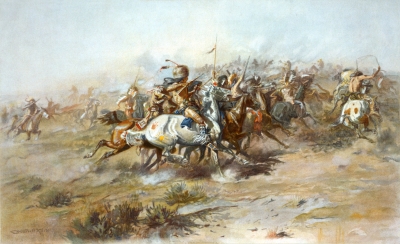
“General” Custer made his famous last stand on the banks of the Little Big Horn river near what is now the interchange for United States highways 87 and 212, in the State of Montana. Today the Custer Battlefield National Monument marks the scene of the battle.
George Armstrong Custer, born in 1839, was called “General” by the men of the 7th Cavalry Brigade under his command. He has shown his brilliance as a cavalry officer in the American Civil War (1861-65) reaching the rank of major general.
In 1876 when Sioux and Cheyennes were on the warpath with Chief Sitting Bull as their leader, Custer and his 7th Cavalry Brigade were under the command of General Terry. The brigade of 655 men was ordered by Terry to advance towards the Indians, but not to attack until the rest of the army-composed of three columns under General Crook, Gibbon and Terry-had moved into position.
Custer reached the Little Big Horn to see the large Indian camp on the opposite side of the river. For a reason that will never be known, Custer decided to disobey orders and attack. Dividing his bridgade into three, he sent Major Reno and Captain Benteen, each with three companies, to attack the flanks. At the same time he led 264 troopers on a frontal approach across the river.
His force stood no chance when the Indians attacked. The troopers dismounted from their horses to seek cover, but there was none. When the Indians drove off their horses, the troopers’ fate was sealed.
Believing that Reno and Benteen would soon come to their aid, they fought bravely, but the flank attacks had been foiled and the cavalry put to flight. Custer and 264 men fought to the last man.
Picture Credit : Google




